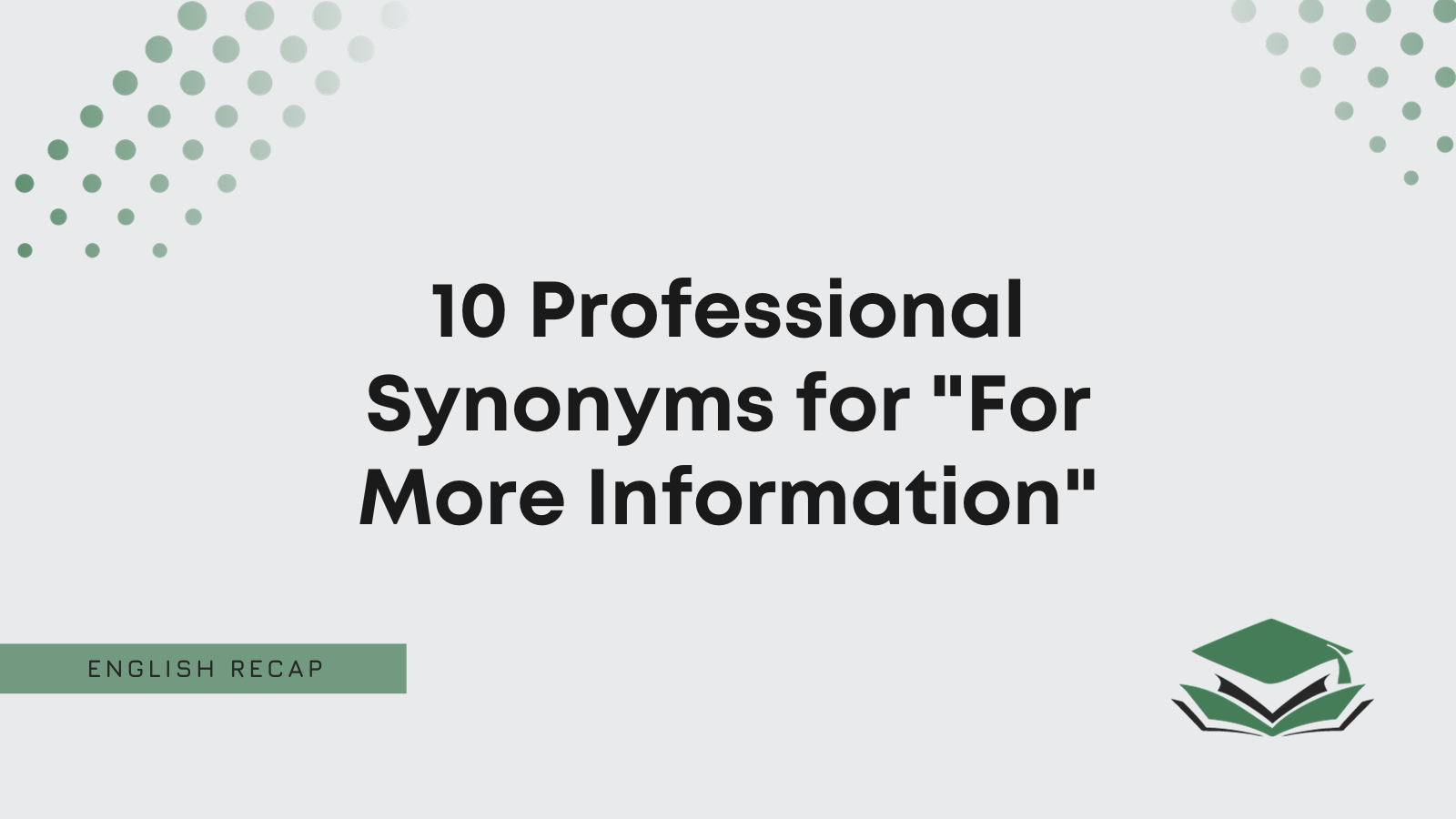So, you want to find a way to share more information with someone.
However, you’re a little worried that “for more information” might not be the best professional choice.
Fear not! We’re here to help.
This article has gathered the best phrases to show you how to say “for more information” in different ways.
Is It Professional to Say “For More Information”?
It is professional to say “for more information.” It’s a great way to let someone know something or provide more information to them.
Generally, you would use it when directing someone to a website. It’s a great way to let people know they can find more information from another source if they spend the time looking for it.
Check out this email sample to learn more:
Dear Ms. Potter,
We hope that’s answered all of your questions.
Please refer to our website for more information if needed.
Yours,
Paul Watford
Pros
- It’s a great way to share more information with someone.
- It is formal and professional.
Cons
- It’s fairly repetitive and generic.
- You need to share extra sources to show where someone can get more information from.
Of course, there’s nothing wrong with using “for more information” in your writing. However, that doesn’t mean it’s the only phrase you can use. There are plenty of great alternatives available.
Keep reading to learn alternative terms for “for more information.” We’ve gathered some great ones, and we’d like you to review them to see which ones work best.
What to Say Instead of “For More Information”
- To learn more
- For further details
- To gain additional insights
- To explore further
- For a deeper understanding
- To delve into the matter
- To acquire more knowledge
- For additional context
- For a more in-depth look
- To discover more about this
1. To Learn More
One of the simplest like-for-like alternatives for “for more information” is “to learn more.”
This is a great way to direct customers to new information. It’s formal and clear, which makes it very easy for customers to keep up with what you’re telling them.
We highly recommend using this when contacting new customers. It shows that you’re interested in keeping them engaged and want to direct them to some more information to help.
Check out this email sample “to learn more” (do you see what we did there?”):
Dear Customer,
Thank you so much for reaching out regarding this new product.
To learn more, refer to our website, and we’ll talk you through your options.
Best,
Sally Martins
2. For Further Details
Next, you can use “for further details” as another way to say “for more information.”
It’s formal and polite, which is great for most emails.
We recommend using it when contacting a client. It lets them know if they’re missing any information. It also suggests you’ll be happy to provide more information for them.
Generally, this is a great way to refer someone’s attention to another site or source. You should include a hyperlink or something to make it understandable for a client to follow.
You should review this email example to find out more about how it works:
Dear Mr. Morrison,
For further details, go to this website.
We think you’ll be very pleased with some of the information you learn.
Kind regards,
Horace Slouch
3. To Gain Additional Insights
You can sound a bit more professional by writing “to gain additional insights.”
It’s a great way to introduce new customers to a company. Generally, this works best in a bulk email when talking to new people interested in what your company can offer.
It’s highly effective as it keeps things direct and sincere.
Feel free to review this sample email to learn more about how to use it:
Dear All,
To gain additional insights, contact our customer service line directly.
We’re more than happy to help you in your time of need.
Yours,
Melanie Black
4. To Explore Further
You can also write “to explore further” instead of “for more information.” This is a great way to generate interest and excitement in an email.
We highly recommend using it when taking on new applicants. It shows that you’d like them to explore more about your company before fully committing to the next stage of an application.
Generally, this is a great choice when trying to entice people to work for you.
You can refer to this sample email to learn more about how to use it:
Dear Applicants,
We’re so happy you’ve decided to learn more about our company.
To explore further, please refer to the attachment to this email.
Thank you so much,
Paul Blart
5. For a Deeper Understanding
You should also write “for a deeper understanding” instead of “for more information.”
This phrase is more professional and clear. It allows the recipient of an email to see exactly where they should go to learn more about the situation you’re telling them about.
We recommend using it when emailing a new client. It shows them that they’re valued, and you’d like to provide them with some more information about what you can help them with.
You can also review this email sample:
Dear Mr. Smith,
This is a really positive step for us, and we look forward to working with you.
For a deeper understanding, please refer to my attachment.
Yours,
Julia Haselgrove
6. To Delve Into the Matter
While it might not be a common choice, “to delve into the matter” is certainly a way to spice up your emails.
You can use it when emailing a business partner. It shows that you’re keen to jump into a partnership with them, but you need to provide them with more information first.
Generally, this is a great way to generate interest in your email. It’s formal and direct, making it clear to partners that you mean business and would like to work alongside them.
If you’re still unsure, you can check out this email example:
Dear Miss Bridges,
It’s great to work alongside you, and I’d like to share more about us before starting our partnership.
To delve into the matter, you can refer to our website.
All the best,
Joe Jacobs
7. To Acquire More Knowledge
Feel free to try “to acquire more knowledge” as another way to say “for more information.”
This is great to use as a formal alternative in your writing.
It shows that you’ve attached a file or link to an email. The recipient can then refer to this if they’d like to learn more about what you’re offering them.
Generally, this works wonders when emailing your boss. It shows that you’ve completed something for them and would appreciate it if they could review it by looking through an attachment.
You should also review this email example to learn more:
Dear Mr. Sully,
To acquire more knowledge about this, please review the attached file.
I think it will provide you with all the information you might need.
Thanks so much,
Max Bradbury
8. For Additional Context
We recommend writing “for additional context” instead of “for more information” as well.
Switching “more” for “additional” and “information” for “context” is a great way to keep your writing engaging.
Also, it helps that this phrase remains professional. So, it’s useful when you want to write an email that catches the recipient’s attention.
Use it when bulk emailing customers. It’s a great way to share a link to your company’s website that might help to answer every customer’s question rather than just one or two.
We also think it’s wise to review this example:
Dear Customers,
We look forward to this strong partnership.
For additional context, please refer to the appropriate pages on our website.
Yours,
Tommy Lochrane
9. For a More In-Depth Look
You can also write “for a more in-depth look” instead of “for more information.”
This works really well when providing information to a client. It should help when you want to share everything your company has to offer but don’t know how to do so efficiently.
Generally, this phrase is formal and to the point. That’s why it’s such a good choice when you’re trying to keep clients engaged with your company.
If you’re still unsure, you can review this sample email:
Dear Ms. Smart,
For a more in-depth look, please review this catalog.
It’s got everything you might need to know about our business in one place.
Warmest regards,
Maddie Bones
10. To Discover More About This
Finally, you can use “to discover more about this” instead of “for more information.”
This is a helpful way to mix things up and let someone know you have more information to share with them.
Try using it in more formal and direct circumstances.
It can work well when contacting excited customers. It’s a great way to engage them and show that you’re keen to keep them interested in what you have to offer.
Here is a great email sample to show you more about how to use it:
Dear Avid Customers,
We’re so excited to introduce you to all the amazing products we have on offer.
To discover more about this, please refer to the attached leaflet!
Thank you so much,
Darren Brown

